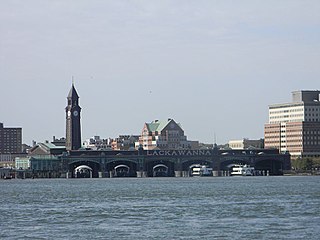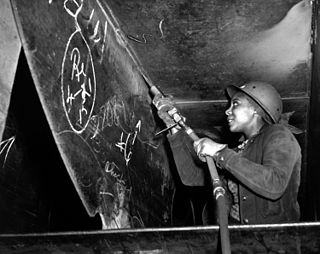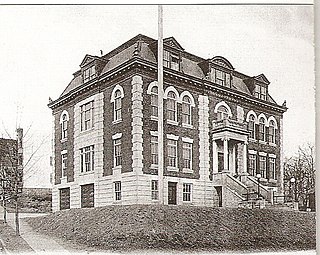
Edgewater is a borough located along the Hudson River in Bergen County, in the U.S. state of New Jersey. As of the 2020 United States census, the borough's population was 14,336, an increase of 2,823 (+24.5%) from the 2010 census count of 11,513, which in turn reflected an increase of 3,836 (+50.0%) from the 7,677 counted in the 2000 census

Hoboken Terminal is a commuter-oriented intermodal passenger station in Hoboken, Hudson County, New Jersey. One of the New York metropolitan area's major transportation hubs, it is served by nine NJ Transit (NJT) commuter rail lines, one Metro-North Railroad line, various NJT buses and private bus lines, the Hudson–Bergen Light Rail, the Port Authority Trans Hudson (PATH) rapid transit system, and NY Waterway-operated ferries.

Rosie the Riveter World War II Home Front National Historical Park is a United States national historical park located in Richmond, California, near San Francisco. The park preserves and interprets the legacy of the United States home front during World War II, including the Kaiser Richmond Shipyards, the Victory ship SS Red Oak Victory, a tank factory, housing developments and other facilities built to support America's entry into World War II. In particular, the role of women and African-Americans in war industries is explored and honored.

The Ford Piquette Avenue Plant is a former factory located within the Milwaukee Junction area of Detroit, Michigan, in the United States. Built in 1904, it was the second center of automobile production for the Ford Motor Company, after the Ford Mack Avenue Plant. At the Piquette Avenue Plant, the company created and first produced the Ford Model T, the car credited with initiating the mass use of automobiles in the United States. Prior to the Model T, several other car models were assembled at the factory. Early experiments using a moving assembly line to make cars were also conducted there. It was also the first factory where more than 100 cars were assembled in one day. While it was headquartered at the Piquette Avenue Plant, Ford Motor Company became the biggest U.S.-based automaker, and it would remain so until the mid-1920s. The factory was used by the company until 1910, when its car production activity was relocated to the new, bigger Highland Park Ford Plant.

The Ford River Rouge complex is a Ford Motor Company automobile factory complex located in Dearborn, Michigan, along the River Rouge, upstream from its confluence with the Detroit River at Zug Island. Construction began in 1917, and when it was completed in 1928, it was the largest integrated factory in the world, surpassing Buick City, built in 1904.

The Ford Richmond Plant, formally the Ford Motor Company Assembly Plant, in Richmond, California, was the largest assembly plant to be built on the West Coast and its conversion to wartime production during World War II aided the United States' war effort. The plant is part of the Rosie the Riveter/World War II Home Front National Historical Park and is listed on the National Register of Historic Places. It currently houses the National Park Service visitor center, several private businesses and the Craneway Pavilion, an event venue.

The New Milford Plant of the Hackensack Water Company was a water treatment and pumping plant located on Van Buskirk Island, an artificially created island in the Hackensack River, in Oradell, Bergen County, New Jersey, United States. The site was purchased in 1881 by the Hackensack Water Company, which developed it for water supply use. The facility was built between 1881 and 1911, and it includes a brick pumping station from 1882, a tall filtration tower, and huge underground infrastructure. The Hackensack Water Company was merged into United Water in the 1980s; the successor today is Suez North America.

The Hudson River Waterfront Walkway, also known as the Hudson River Walkway, is a promenade along the Hudson Waterfront in New Jersey. The ongoing and incomplete project located on Kill van Kull and the western shore of Upper New York Bay and the Hudson River was implemented as part of a New Jersey state-mandated master plan to connect the municipalities from the Bayonne Bridge to the George Washington Bridge with an urban linear park and provide contiguous unhindered access to the water's edge.

The Lembeck and Betz Eagle Brewing Company was founded in 1869 by Henry B. Lembeck and John F. Betz in Jersey City, in Hudson County, New Jersey, United States. The brewery, bounded by 9th, 10th, Grove, and Henderson streets in downtown Jersey City, developed into one of the most famous, best-equipped, and financially successful breweries on the East Coast of the United States.

The Piquette Avenue Industrial Historic District is a historic district located along Piquette Street in Detroit, Michigan, from Woodward Avenue on the west to Hastings Street on the east. The district extends approximately one block south of Piquette to Harper, and one block north to the Grand Trunk Western Railroad Line. It was listed on the National Register of Historic Places in 2004.

The Binghamton was a ferryboat that transported passengers across the Hudson River between Manhattan and Hoboken from 1905 to 1967. Moored in 1971 at Edgewater, Bergen County, New Jersey, United States, the ship was operated as a floating restaurant from 1975 to 2007. In 2017, following ten years of damage that effectively rendered the boat unrestorable, the ferry was dismantled. No structural components were salvaged.

Edgewater Borough Hall is located in Edgewater, Bergen County, New Jersey, United States. The building was added to the National Register of Historic Places on January 16, 2008. The building was constructed in 1904.

The Alcoa Edgewater Works was located in Edgewater, Bergen County, New Jersey, United States. The building was built in 1916 for the Alcoa company and added to the National Register of Historic Places on August 10, 1978. The building has since been demolished.
The Edgewater Cemetery is a cemetery in the Bergen County, New Jersey community of Edgewater.

The Edgewater Branch was a branch of the New York, Susquehanna and Western Railway (NYS&W) that ran about 3.174 miles (5.108 km) through eastern Bergen County, New Jersey in the United States. Starting from a rail junction at the Little Ferry Yard, it went east through the Edgewater Tunnel to Undercliff to the Hudson Waterfront.

The Cambridge Assembly was a Ford Motor Company factory in Cambridge, Massachusetts which opened in 1913. The factory had the first vertically-integrated assembly line in the world. It was replaced in 1926 by the Somerville Assembly. The plant was later reused by Polaroid Corporation, and is now owned by the Massachusetts Institute of Technology.
Long Beach Assembly is a former Ford Motor Company assembly plant located at the Cerritos Channel on Terminal Island, at 700 Henry Ford Avenue in Long Beach, Southern California. It operated from 1930 through 1958.
Mahwah Assembly was a Ford Motor Company manufacturing plant in Mahwah, New Jersey, 30 miles from New York City. It occupied over 172 acres.

The Bergen Tunnels are a pair of railroad tunnels with open cuts running parallel to each other under Bergen Hill in Jersey City, New Jersey, U.S. Originally built by the Delaware, Lackawanna and Western Railroad (DL&W), they are used by New Jersey Transit Rail Operations (NJT) trains originating or terminating at Hoboken Terminal.





















